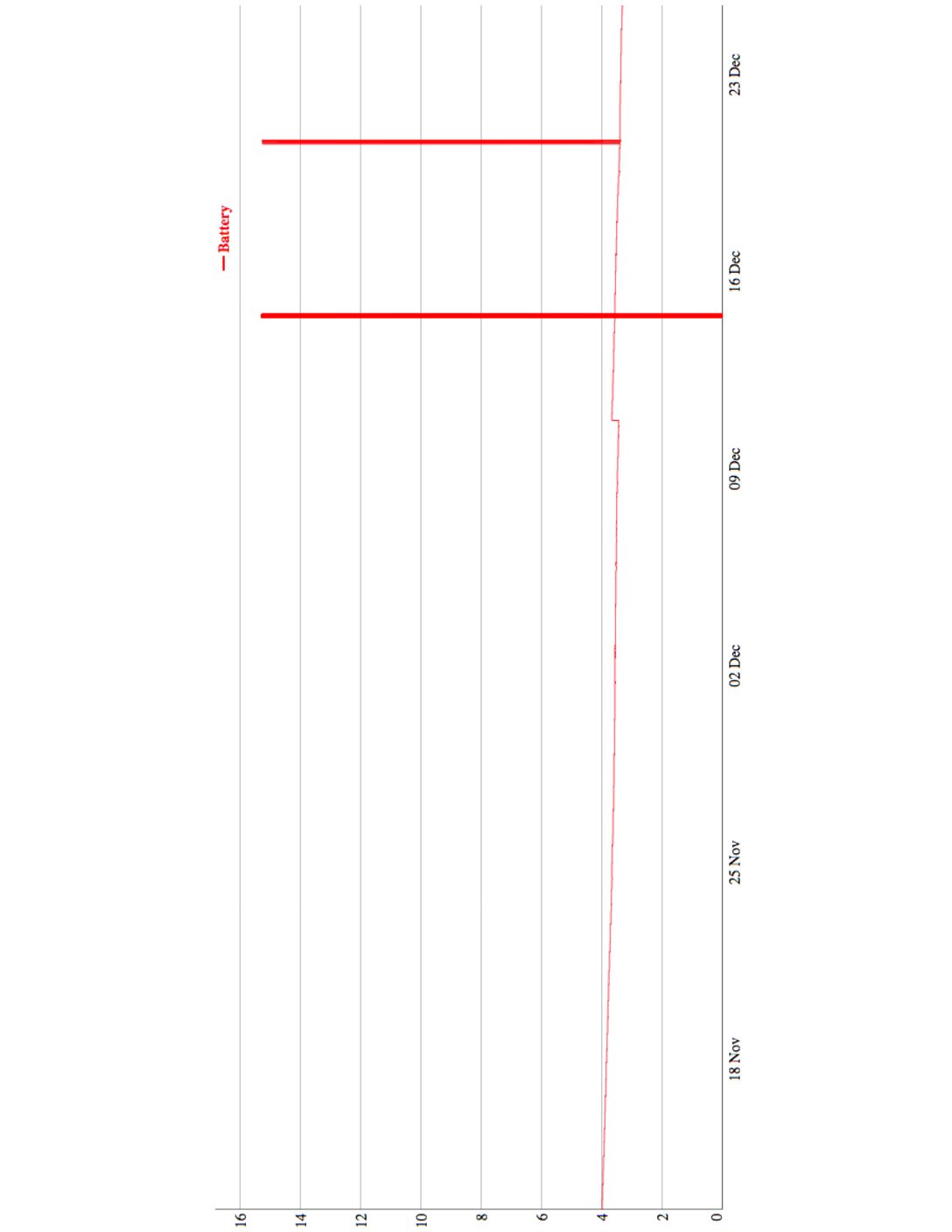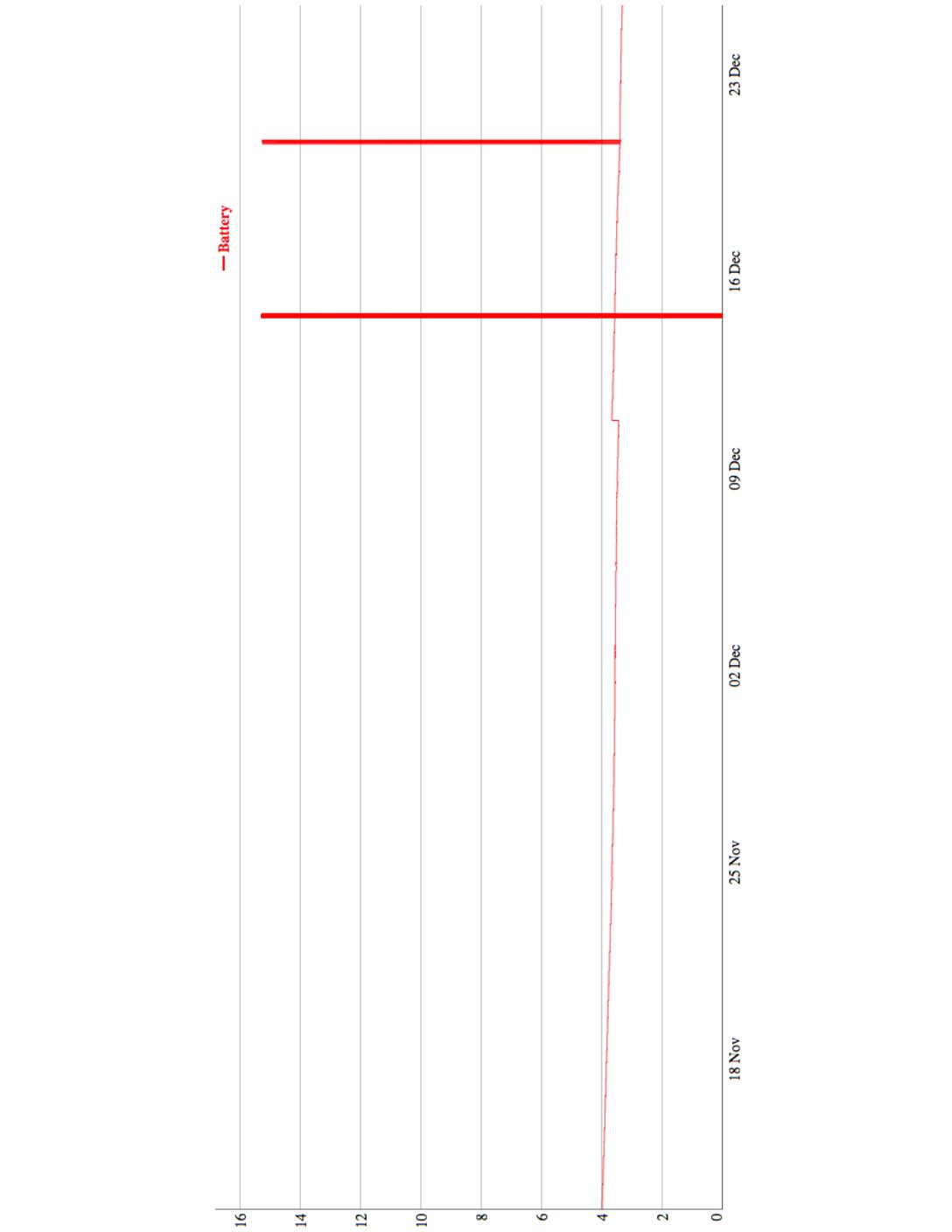Hardware Technical Support
Tagged: Flood Damage, Hardware Technical Support
- This topic has 12 replies, 5 voices, and was last updated 10:17 AM on 2019-04-16 by David Bressler.
-
AuthorPosts
-
2017-07-21 at 1:41 PM #153130
 David BresslerParticipant
David BresslerParticipantPurpose: hardware/mechanical issues and troubleshooting, upgrade and maintenance of hardware
2017-07-21 at 1:41 PM #74271 David BresslerParticipant
David BresslerParticipantRecommendation for groups to get battery charges (and adaptor) and possibly largest battery
The large battery that we usually put in stations:https://www.adafruit.com/product/354
LiPo battery charger:
https://www.sparkfun.com/products/12711Power cord for charger:
https://www.sparkfun.com/products/14158If someone needs a jumbo-size battery for places with lots of shade, or for non-cellular stations they don’t want to check as often, this is the biggest battery available:
https://www.adafruit.com/product/3532017-08-14 at 8:33 AM #74279 David BresslerParticipant
David BresslerParticipantTroubleshooting for sites with marginal cell signal (i.e., where cell signal may be lost and data stops transmitting for a period of time): Loggers may “lock up” and stop connecting to the cellular network after a period where the cell network was unavailable or had extremely low signal strength. The only way to get them to “reconnect” is to just cycle the power on the logger. Anytime you see a logger go offline and the battery voltage wasn’t too low (below 3.7v) the last time the network “heard” from the logger, then someone should just simply go to the station and cycle the power using the power switch on the Mayfly. There’s absolutely nothing wrong with cycling the power anytime the stations acts strange. You should also swap out the memory card when you do this to see if the station has been recording data on the card during the cellular outage, or if for some reason the entire logger was paused. Further, in cases where the station has marginal cell signal strength (and data transmission stops at times), after the signal is lost the cellular module doesn’t re-join the network properly, so someone has to go out and restart the station. Should also look at the data card data to see what the battery voltage looks like for the times the logger is offline.
2017-12-06 at 6:11 PM #112392Matt Barney
ParticipantHello,
I want to build a cell signal tester with display, like the one Shannon demonstrated during a recent workshop, and I have a few questions. I’m working from the parts list that I received while at Stroud. I mostly need help sourcing the components, as the Mayfly Starter Kit doesn’t appear to be available on Amazon at the moment.
- What is a good source for the GPRSbee module? SODAQ is out of stock, and seeedstudio no longer carries them. Mouser and DigiKey show them as ‘obsolete’.
- Will I need to purchase the antenna separately?
- LCD/LED display: Do you have suggestions for one to use?
- What size solar panel do you recommend?
- Shannon, would you be willing to share the sketch you wrote for this?
- We also talked about adding a GPS receiver so that it would log signal strength and location as you moved around. If you have any tips and/or code for this, I’d be interested.
Sorry for starting with a barrage of questions! I’ve been searching around and haven’t been able to find answers.
Thanks,
Matt2017-12-09 at 1:12 PM #147842Shannon Hicks
ParticipantI talked to the GPRSbee designers at SODAQ, and they should have more of the modules in stock next week. You’ll have to order directly from SODAQ’s website, they aren’t available anywhere else. The GPRSbee comes with an antenna, you don’t need to buy anything else to make it work as a signal-strength tester. If you want to use a module for actually sending data, you will need a SIM card for a carrier that has 2G service, and the best option for that is http://hologram.io
But you don’t need a SIM card if you’re just making a signal tester.As for the solar panel, the 0.5w panel from Seeedstudio fits inside the clear-lid enclosures I usually use for the Mayfly, but you have to modify the panel to get it to fit since it’s about 4mm too long. I use a special “nibbler” tool to do that, because if you don’t do it carefully it will damage the panel. You don’t actually have to use the solar panel if you’re building a signal tester. I just do it so that the battery can be recharged easier since we loan those kits to people who don’t have battery chargers.
Probably the easiest thing to buy for building all of this would be to use our Mayfly Starter kit: https://www.amazon.com/dp/B01FCVALDW
It’s currently out of stock, but we’ll hopefully have more online in a few weeks. It come with the clear-lid case, has the solar panel, and the Grove cable you’ll need to connect to the display.The display I like to use with the Mayfly is this one: https://www.amazon.com/Grove-128×64-Board-Arduino-Raspberry/dp/B01D5GLDJ2
It has a Grove port on it so you can simply connect it to the Grove I2C port on the Mayfly. There are other similar displays that will work, but none that are as easy to connect since I only know of this one display with a Grove port.If you wanted to add a GPS module, you’d need a way to connect it to the Mayfly. There are a couple different ways to do it, but it depends on which GPS module you want to use. I could suggest a few ways if you really want to do it.
As for the code, I can also provide that. If you’re using the SwitchDoc OLED display I mentioned above, you’ll need the drivers from here: https://github.com/switchdoclabs/SDL_Arduino_SSD1306
The code:#include <SDL_Arduino_SSD1306.h> // Modification of Adafruit_SSD1306 for ESP8266 compatibility #include <AMAdafruit_GFX.h> // Needs a little change in original Adafruit library (See README.txt file) #include <SPI.h> // For SPI comm (needed for not getting compile error) #include <Wire.h> // For I2C comm, but needed for not getting compile error SDL_Arduino_SSD1306 display(4); // FOR I2C long previousMillis = 0; // will store last time display was updated // Comment out one of the 2 lines below, depending on your Mayfly version // float batt_ratio = 1.47; // Use this line for Mayfly v0.3 and v0.4 float batt_ratio = 4.7; // Use this line for Mayfly v0.5 and newer int batteryPin = A6; // select the input pin for the potentiometer int batterysenseValue = 0; // variable to store the value coming from the sensor float batteryvoltage; // the follow variables is a long because the time, measured in miliseconds, // will quickly become a bigger number than can be stored in an int. long interval = 5000; int index = 1; void setup() { Serial.begin(57600); //Start the serial connection with the computer Serial1.begin(9600); //UART to the Bee module pinMode(23, OUTPUT); // Bee socket DTR pin digitalWrite(23, HIGH); // on GPRSbee v6, setting this high turns on the GPRSbee. leave it high to keep GPRSbee on. pinMode(8, OUTPUT); // Mayfly Green LED digitalWrite(8, HIGH); //turn on the Green LED display.begin(SSD1306_SWITCHCAPVCC, 0x3C, false); // initialize with the I2C addr 0x3C (for the 128x64) display.clearDisplay(); display.setRotation(2); display.setTextSize(2); display.setTextColor(WHITE); display.setCursor(0,0); display.println("Mayfly"); display.println("GPRS 2G"); display.println("Signal"); display.println("Tester"); display.display(); Serial.println("Mayfly GPRS 2G RANGE TESTER"); //prints to the computer serial delay(100); } void loop() { unsigned long currentMillis = millis(); if(currentMillis - previousMillis > interval) { previousMillis = currentMillis; Serial1.print("AT+CSQ\r"); // query the Bee module for signal strength report delay(2000); int s = Serial1.parseInt(); int junk = Serial1.parseInt(); batterysenseValue = analogRead(batteryPin); batteryvoltage = (3.3/1023.) * batt_ratio * batterysenseValue; Serial.print("s= "); Serial.println(s); if (s == 0) { Serial.print(" None"); } else if (s > 1 && s <= 9) { Serial.print(" Bad"); } else if (s >= 10 && s <= 14) { Serial.print(" Ok"); } else if (s >= 15 && s <= 19) { Serial.print(" Good"); } else if (s >= 20 && s < 31) { Serial.print(" Great!"); } float percent = map(s, 0, 30, 0, 100); // redefines the 0-30 levels to a 0-100% range display.clearDisplay(); display.setTextSize(2); display.setTextColor(WHITE); display.setCursor(1,0); display.print("Sample:"); display.println(index); display.print("Signal:"); display.print(percent,0); display.println("%"); display.print("Qual:"); if (s == 0) { display.print("None"); } else if (s > 1 && s <= 9) { display.print("Bad"); } else if (s >= 10 && s <= 14) { display.print("okay"); } else if (s >= 15 && s <= 19) { display.print("Good"); } else if (s >= 20 && s < 31) { display.print("Great"); } display.println(); display.setTextSize(1); display.print("1-30: "); display.println(s); display.print("Battery: "); display.print(batteryvoltage); if (batteryvoltage > 3.75) { display.print(" ok"); } else if (batteryvoltage < 3.75) { display.print(" LOW!"); } display.display(); index++; } }2017-12-11 at 4:24 PM #147844Matt Barney
ParticipantHi Shannon,
Awesome – thank you so much for all of that. I will keep an eye on SODAQ for the availability of the GPRSbee soon. Thanks for mentioning the SIM – it hadn’t occurred to me that it was unnecessary when one is only doing signal testing. I may hold out until after the holidays to see if the Mayfly starter kit becomes available again; if not, I might just start piecing together on my own. I’ll hold off on the GPS functionality for now until I get the other bits together. Thanks for your code too!
Best,
Matt2017-12-20 at 11:38 AM #147849Matt Barney
ParticipantFYI, the GPRSbee modules are back in stock at SODAQ. -Matt
2018-12-27 at 9:44 AM #153152Paul Wilson
ParticipantWell the high water just before Christmas took it’s toll. But it could have been worse. The large rock in front of the station held it in place even though the log had broken the pipe holding it (see photo). The sensor pod and “depth spike” backup stream gauge (more on this later) were fine. But the stream gauge does not look so good 🙂 The station is still on line and I’ll be making repairs tomorrow if weather allows. Might try to move the stream gauge to a bridge abutment upstream. Seems pointless to put it back where it was to get smacked again.
2018-12-29 at 1:04 PM #153155Carol Armstrong
ParticipantThe battery at SL117 stopped transmitting altogether on 12/25/18 – pattern shown in attached image. On trouble shooting the board on 12/28/18, all lights were off. On turning the board off and on, the green and red light that alternately blink quickly occurred. However, no other light came on. Working with the board turned off, the battery connector would not come out of the board, despite persistent efforts, but no damage occurred; so the battery was not changed. The antenna was found laid on the circuit board, and not tucked outside the board behind the insulation, where it must be kept so as not to damage the board. Could not switch out the memory card to see if it had been recording data even after the Mayfly stopped transmitting, because did not have an erased card available. Shannon and Rachel – your thoughts? This station uses only a CTD sensor, and at the bottom of the box has one cable gland for the CTD, and a smaller cable gland for the solar panel. The cable for the solar panel was not connected to anything. Is this is the reason why the battery needed recharging every few weeks since 8/30/18 when the battery size was switched, or did the solar panel come out earlier after the vandalism in July?
Attachments:
2018-12-30 at 12:27 PM #153158Shannon Hicks
ParticipantAccording to the latest data sent to the website, the battery voltage is too low (3.34v) to power the cellular module. There’s just enough power to start the board and blink the lights, but that’s it. So the battery needs to be replaced. The plug on the battery connector has two small “teeth” that help hold it into the jack on the Mayfly, but sometimes those teeth can be a little too sharp which cause them to want to stick in the jack and not come out easily, so I’ll take an exacto knife to them to round them off a little when I build the station, but I’m guessing that’s a replacement battery that’s currently in there. I think the solar panel was removed from that station because of vandalism, so if there’s no panel, then it’s okay if the solar panel cable inside the enclosure isn’t connected to the Mayfly. But the cellular antenna should definitely be tucked out of the way and put between the plastic Mayfly box and the foam. If not, the exposed metal on the antenna board can come in contact with exposed metal on the Mayfly and short-circuit the board.
If this station is going to be operated permanently without a solar panel, then we should put a larger battery pack in there, or remove the cellular board so that the battery will last several months instead of just a few weeks.
-
AuthorPosts
- You must be logged in to reply to this topic.




